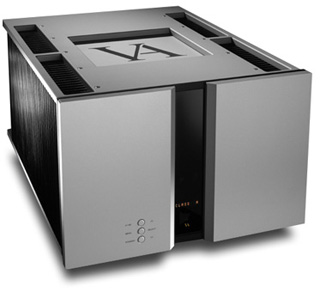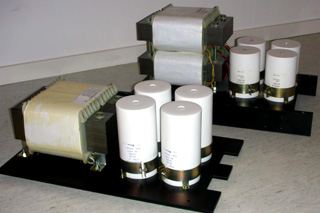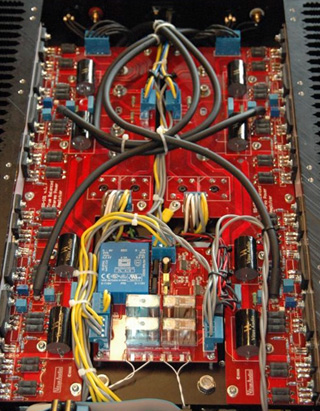 |
||
| October 1, 2006 Searching for the Extreme: Vitus Audio
Getting the music to sound right to Hans-Ole Vitus took an extraordinary amount of work. From my recent interview with him, I came away impressed at his seemingly exhaustive approach to designing cost-no-object electronics. Inquiring about the design elements that seem most prominent in the Danish-made Vitus line, it was apparent that compromise was limited. Vitus, as he likes to be called, was quite forthcoming with details on an expanding collection of products: The Vitus Signature lineup consists of a set of mono amplifiers, the SM-101s ($49,000); the new stereo SS-101 ($28,000); the SL-100 preamplifier ($28,000) and SP-100 phono amplifier ($26,000); the SS-010 integrated amplifier ($12,000); and the forthcoming SCD-010 CD player ($12,000). Last but not least, their new series of cables -- called Andromeda -- is currently being introduced to the market. The man behind these cables is Anders Grove, founder of and former designer for Argento Audio, and cofounder of Vitus Audio. The Andromedas’ prices range from $1235 for a digital interconnect to $5865 for a pair of speaker cables. Two of the key design elements that help define the Vitus approach are 1) no negative feedback is used in the circuit design, and 2) the signal path is balanced from input to output. Although any of the individual elements that make up a Vitus product can be found in other, less expensive products, their implementation in a Vitus component is accomplished with little regard to cost or practicality. Unlike with some expensive electronics, however, there is little frippery. Consider the new SS-101 stereo power amplifier, which delivers 50Wpc of class-A power -- hardly a number meant to impress on a spec sheet. But this 50W amp weighs 170 pounds. Transformer design One subject Hans-Ole Vitus is opinionated about is transformer design. Some of his positions fly in the face of common thinking, such as his abhorrence of the toroidal transformers used in many of today’s most respected high-end products. Vitus uses UI-core transformers of his own design: "It took us about four years of development together with one of the leading transformer designers in Denmark to get to the result we use in our designs today. We have tested pretty much every possible transformer technology in a large range of different applications to find the best-suited topology for our designs. We have spent substantial engineering effort to, firstly, measure and qualify each transformer design in order to prove the given specifications. A UI-core transformer produces exactly the level of stability and clarity we are after, and the special design basically eliminates the need for external power conditioners, which at this power range (the transformer used in a SM-101 is rated at 2.2kVA) becomes quite a challenge in both manufacturing and actual performance." Vitus found that toroidals’ only two advantages over UI and EI designs are of price and size: they are relatively inexpensive and physically small. But in every other parameter, according to Vitus, toroidals failed to pass muster. The UI-core transformer that Vitus uses is large, heavy, and expensive, but excels in some specific technical areas that in his mind are critical to power-supply design, among them low capacitive coupling to the mains, low magnetic radiation, and low voltage drop. "We looked at a number of other parameters, which are a part of our intellectual property and hence cannot be disclosed. This includes the actual choices of materials and the way of production. [The UI transformer] offers superior performance over its competitors -- and price, size, and weight have no priority in our current series of products." Although Vitus is a measurements guy in the sense that objective data must be proven to his satisfaction, he’s also a listening guy: "Taking the amplifiers through our complete listening procedure is most important. When done, we gathered the [listening and measured] results and made the obvious conclusion: using our current UI custom-made transformer is the best." Negative feedback
There is no question these days that the use of negative feedback in amplifier design is a polarizing subject. I was anxious to get the Vitus stand on the subject: "We do not employ any form of negative feedback. This is one of the really hot topics amongst different manufacturers, and most seem to be in favor of using feedback. My personal take on this subject is that when using feedback, phase errors will occur. Where the human ear cannot detect smaller amplitude errors, even very small phase errors will be detected immediately. During my employment with Texas Instruments I was heavily involved in the hearing-aid business, as much of the manufacturing is based here in Denmark. Through this work I learned quite a bit about the human ear and how even very small phase variations are detected immediately." Balanced and class A I asked Vitus if he felt that balanced class-A analog designs have significant advantages over other topologies, and if so, why. I wasn’t surprised at the response: "Yes and no! In general, I believe that attention to detail makes the largest difference. Balanced designs give a higher level of immunity to noise over nonbalanced products, but there are many other challenges as the design is more complex. It forces the designer to pay more attention to details. As for class A over class AB, I personally prefer class A. It tends to add some warmth and clarity to the music and it has a deeper and more firm grip in the bass. Last but not least, the midrange is sweeter. Overall, I like to be able to listen to music hour after hour without getting tired and developing a headache! With the combination of ultra-high resolution, superior dynamics, and the emotional touch class A gives, I just never get tired of spinning records." Getting a Vitus product to market The development of Vitus Audio products involves much listening, much measuring, then more listening and measuring, and so on until everything is just right. When a product is under development, measuring in the lab and listening in the field are keys to the process. Vitus expands: "Once we have made sure the new product measures acceptably, we turn our focus to what it’s all about: music. Does the product under development reproduce high-quality sound? Will we end up tired after some hours of listening? Then back to the drawing board: make changes, measure, listen for some hours, over and over, until we are happy with the design. Once we have reached the point where we are completely happy with the performance, we turn to external testers. "In the early days (prior to 2000), we spent many weekends traveling around Denmark demonstrating our early prototypes. From these early days we have a number of ‘test persons’ with very-high-quality two-channel systems and good hearing; we still use these people for final sound and function testing. Once the product is returned, they fill in a questionnaire giving us valuable feedback on their findings. Should their feedback give us a reason for going back to the lab (which was the case for the SCD-010 CD player, hence the delay in introduction), we will do the whole ‘field test’ again." Vitus Audio being a relatively new firm based in Denmark, getting the word out on Vitus products and what sets them apart is critical. I asked Vitus what he wanted potential customers to know about his company. "Well, first of all, I would say as I always say -- music is a matter of personal taste -- and taste cannot be predicted! Therefore I recommend that potential customers arrange for a home demonstration to be able to spend time spinning their own records. This way they will hopefully understand what the team behind our products is driven by -- the love for music!" How will the brand-new SS-101 stereo amplifier perform in "The World’s Best Audio System"? You’ll be the first to know. ...Jeff Fritz To learn more about Vitus Audio's products, visit www.vitusaudio.com.
Ultra Audio is part of the SoundStage! Network. |


